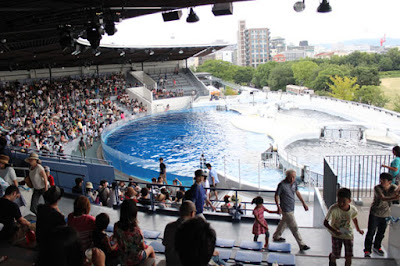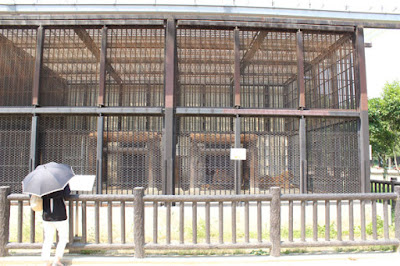When
Kyoto Aquarium was opened in March 2012, many people questioned the wisdom of building
an aquarium in this landlocked city.
Located far from the ocean and some distance from the nearest lakes and
large rivers, the new aquarium seemed out of place in what most tourists
consider to be the cultural capital of Japan.
With so many historical and cultural attractions in Kyoto
Rivers of Kyoto Zone
After entering the aquarium,
the first exhibit the visitor encounters is dedicated to the natural stream environments
in the
Despite
their rather grotesque appearance, these animals are quite popular among
visitors. And the glass-wall design of
the exhibit allows visitors to get a very close look.
I
think there were about eight individuals sleeping together in this pile of
salamanders.
A
separate exhibit in this zone featured many different types of fish native to Japan
Sea Animals (Mammals) Zone
This area features two large
tanks with clear acrylic walls. One
houses six South American Fur Seals (Arctocephalus
australis ) and the second houses two Larga Seals (Phoca largha ).
Visitors can view the seals very up close from many different angles.
The cubicle shown below allows visitors to even see the animals from below.
Despite
the close proximity, the animals appeared to be accustomed to the crowds of
people.
Penguin Zone
This zone features an indoor
area with a large window allowing visitors to watch the African Penguins (Sphenicus demersus ) swim overhead.
Main Pool
This large tank recreates the
ocean environments surrounding
Another
impressive feature of this aquarium is the water quality. The water in the tanks, both the fresh water
exhibits and the salt water exhibits, appear to be very clean. Considering that this facility is so far from
the ocean, this suggests the use of rather high-quality water filtering
technology.
Ocean Zone
This
zone features an exhibit resembling a shore reef, and a series of tanks showcasing
many different types of small invertebrates and jellyfishes.
Some
of the exhibits were built at a height just right for small children.
Beauty of Nature Zone
This zone features
smaller-sized tanks showing the environments of freshwater streams. It is a very low-key, but very interesting
display.
Countryside of Kyoto
Zone
This outdoor zone replicates a
stream flowing through an agricultural village.
There is a small rice paddy and a vegetable garden that are actually
farmed, and the stream is home to small fishes, aquatic insects, and frogs.
There
is also a shallow pool on the edge of this zone. During the hotter seasons, small children use
this as a wading pool. I noticed that
many parents were prepared with extra changes of clothes for their children. This suggests that this feature is sufficiently
well-known that families plan ahead to let their children get wet.
Dolphin Stadium
There were eight Bottlenose
Dolphins (Tursiops truncatus) in
residence in this zone. Judging by the
fact that the amount of space dedicated to this zone comprises about one-third
of the physical area of the entire aquarium, it is probably safe to conclude
that the presence of the dolphins is quite important to this facility. Unfortunately, one gets the impression that
the dolphins are utilized more as a tool of simple entertainment than of education.
The dolphins participate in numerous shows each day, and the contents of the
show I observed seemed to be more about their ability to perform clever circus-type
tricks rather than about their biological characteristics and lifestyle in the
wild.
Another
matter of concern is the size of the pools in which the dolphins live. This zone was comprised of a large pool and
three smaller holding pools. The main pool was probably about 50 meters wide by
20 meters from front to back. The middle
holding pool looked to be about 20 meters wide and about 8 meters from front to
back. The two side holding pools appeared to be about 15 meters wide and about
8 meters from front to back. Whether
this amount of space is adequate for these eight large marine mammals is a
matter open for debate. Recently in some
countries, the very concept of keeping cetaceans in captivity has grown into a
heated disagreement.
Complicating
matters, in April 2015, the World Association of Zoos and Aquariums (WAZA)
temporarily suspended the membership of the Japanese Association of Zoos and
Aquariums (JAZA) over a controversy related to the drive fishery method used to
collect wild dolphins for sale to aquariums.
(WAZA reinstated JAZA’s membership after JAZA’s member zoos and aquariums
voted to refrain from buying dolphins caught in drive fisheries.) I don’t know whether the dolphins at Kyoto
Aquarium were caught from the wild or were bred in captivity, but this
controversy reportedly will make it more difficult for aquariums in Japan
Educational Efforts
There
were many educational displays throughout the facility, including the type of identification
signage typically found next to animal displays.
There
were also more artistic arrangements like this one explaining the theorized evolution
of penguins.
This
illustrated panel located on the ramp outside of the penguin enclosure showed
the world’s different types of penguin species and their respective sizes.
Opportunities for
Animal Encounters
The exhibit in the “Fun
Learning at the Beach” area in the Ocean zone looked like it was designed to be
a touch tank, but on the particular day of my visit, I did not observe any animal
touching events. Considering the large
crowd of people and the stress it can cause to the animals, I think that was a
good thing.
Food and Souvenirs
Next to the seals enclosure,
there was a concession stand selling sandwiches, drinks, and shaved ice. There was another concession next to the
dolphin stadium and also one in the “Beauty of Nature” zone. With respect to souvenirs, there was a temporary
set up located on the second floor and a permanent full-scale shop on the first
floor next to the exit. There were many toys,
trinkets, and branded snacks and cookies.
These
Giant salamander plush toys were very popular – sufficient proof that a cute
plush toy can improve the image of even a grotesque looking animal.
The
Giant Salamander figures on these pens recreate how the salamanders like to
pile upon each other.
For
serious amphibian lovers: a life-sized Giant Salamander plush toy - only 25,720
yen.
Getting There
The
Kyoto Aquarium is about a 10 to 15 minute walk from JR Kyoto train
station. After exiting the station’s
central exit on the North side, head west towards Umekoji Park
(Note:
All photos taken in this post were taken during a visit on August 12, 2015. The comments in this post are based on
observations made on that day.
Conditions may have since changed.
Please check it out for yourself!)




































































